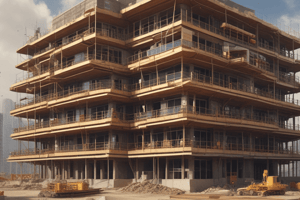Podcast
Questions and Answers
What is one key purpose of proper documentation in construction projects?
What is one key purpose of proper documentation in construction projects?
- To simplify communication among unqualified workers
- To increase the overall project cost
- To make daily activities less accountable
- To provide a basis for efficient storage and retrieval of information (correct)
Which of the following elements is NOT typically included in a job log?
Which of the following elements is NOT typically included in a job log?
- Employee Salaries (correct)
- Daily Activities
- Deliveries and Inventory
- Weather Conditions
How does documenting issues and resolutions in a job log benefit future projects?
How does documenting issues and resolutions in a job log benefit future projects?
- It complicates future project activities.
- It ensures complete memorization of problems.
- It reduces the need for any documentation.
- It helps avoid similar issues in upcoming projects. (correct)
What critical effect does improper documentation have on a construction project?
What critical effect does improper documentation have on a construction project?
Why is it important to note the weather conditions in a job log?
Why is it important to note the weather conditions in a job log?
What does the job log help to maintain during a construction project?
What does the job log help to maintain during a construction project?
What happens if project documentation is created after the fact?
What happens if project documentation is created after the fact?
Which of the following is a function of proper job site documentation?
Which of the following is a function of proper job site documentation?
What is the primary benefit of written communication on a construction site?
What is the primary benefit of written communication on a construction site?
Why must the site superintendent be aware of diverse cultural backgrounds?
Why must the site superintendent be aware of diverse cultural backgrounds?
What must be recorded for every meeting on a construction site?
What must be recorded for every meeting on a construction site?
How should the minutes of the meeting be handled after they are recorded?
How should the minutes of the meeting be handled after they are recorded?
What is one reason minutes of the meeting are considered an official record?
What is one reason minutes of the meeting are considered an official record?
What aspect of the minutes of meetings improves accountability?
What aspect of the minutes of meetings improves accountability?
How does poor communication affect a construction site?
How does poor communication affect a construction site?
What is the significance of storing written communications with project stakeholders?
What is the significance of storing written communications with project stakeholders?
What is the primary purpose of quality control (QC) reports in construction?
What is the primary purpose of quality control (QC) reports in construction?
Which aspect is NOT typically included in quality control reports?
Which aspect is NOT typically included in quality control reports?
What do record or as-built drawings represent?
What do record or as-built drawings represent?
How are minor changes made during construction documented?
How are minor changes made during construction documented?
What role do quality assurance measures play in construction projects?
What role do quality assurance measures play in construction projects?
Why are photographs included in quality control reports?
Why are photographs included in quality control reports?
Which of the following best describes the significance of QC reports in construction disputes?
Which of the following best describes the significance of QC reports in construction disputes?
What could be a potential outcome of not adhering to quality control standards?
What could be a potential outcome of not adhering to quality control standards?
What is the primary purpose of a field authorization/change directive?
What is the primary purpose of a field authorization/change directive?
What must occur before the contractor can claim a future change order based on a field authorization/change directive?
What must occur before the contractor can claim a future change order based on a field authorization/change directive?
What is the typical financial implication of issuing supplemental instructions?
What is the typical financial implication of issuing supplemental instructions?
How are timecards primarily utilized in a construction setting?
How are timecards primarily utilized in a construction setting?
What action should a contractor take if they believe a supplemental instruction will affect project cost or time?
What action should a contractor take if they believe a supplemental instruction will affect project cost or time?
What distinguishes a field authorization/change directive from a formal change order?
What distinguishes a field authorization/change directive from a formal change order?
What is the role of project consultants when they issue supplemental instructions?
What is the role of project consultants when they issue supplemental instructions?
Why is it important for a contractor to have documentation for field authorization/change directives?
Why is it important for a contractor to have documentation for field authorization/change directives?
What is the earliest day a claim is considered discovered?
What is the earliest day a claim is considered discovered?
Under what circumstance can a claim be considered out of time due to the Statute of Limitations?
Under what circumstance can a claim be considered out of time due to the Statute of Limitations?
What must be proven if a delay in discovering a claim occurs?
What must be proven if a delay in discovering a claim occurs?
What is the significance of the ultimate limitation period in the context of the Limitations Act?
What is the significance of the ultimate limitation period in the context of the Limitations Act?
Which of the following is NOT a factor in determining the discovery of a claim?
Which of the following is NOT a factor in determining the discovery of a claim?
In the provided example of the shed, when is the claim presumed to be known?
In the provided example of the shed, when is the claim presumed to be known?
What does the Limitations Act say about claims discovered after the ultimate limitation period?
What does the Limitations Act say about claims discovered after the ultimate limitation period?
What role does a reasonable person's perspective play in the claim discovery process?
What role does a reasonable person's perspective play in the claim discovery process?
What typically initiates the warranty period for a construction project?
What typically initiates the warranty period for a construction project?
Which of the following is NOT included in a testing and commissioning report?
Which of the following is NOT included in a testing and commissioning report?
What type of information should be captured in the 'lessons learned' section after project completion?
What type of information should be captured in the 'lessons learned' section after project completion?
Which system is NOT typically included in the testing and commissioning process?
Which system is NOT typically included in the testing and commissioning process?
Who is responsible for preparing the warranty checklist?
Who is responsible for preparing the warranty checklist?
Which documentation is necessary for legal disputes?
Which documentation is necessary for legal disputes?
What should be included in a project close-out documentation package?
What should be included in a project close-out documentation package?
When do extended warranties typically begin?
When do extended warranties typically begin?
Flashcards
Job Site Documentation
Job Site Documentation
A structured record of construction project events and activities, providing a chronological history, enabling easy access to project information, and preventing data loss.
Job Log
Job Log
A daily record of construction activities, including tasks, materials, weather, personnel, deliveries, inspections, issues, and changes.
Job Log: Daily Activities
Job Log: Daily Activities
Detailed record of work completed each day, including tasks, materials, equipment, and issues.
Job Log: Personnel
Job Log: Personnel
Signup and view all the flashcards
Job Log: Deliveries & Inventory
Job Log: Deliveries & Inventory
Signup and view all the flashcards
Job Log: Inspections & Tests
Job Log: Inspections & Tests
Signup and view all the flashcards
Job Log: Issues & Resolutions
Job Log: Issues & Resolutions
Signup and view all the flashcards
Job Log: Changes & Updates
Job Log: Changes & Updates
Signup and view all the flashcards
Claim Discovery
Claim Discovery
Signup and view all the flashcards
Claim Knowledge Elements
Claim Knowledge Elements
Signup and view all the flashcards
Reasonable Person Standard
Reasonable Person Standard
Signup and view all the flashcards
Limitation Period
Limitation Period
Signup and view all the flashcards
Ultimate Limitation Period
Ultimate Limitation Period
Signup and view all the flashcards
Act or Omission Date
Act or Omission Date
Signup and view all the flashcards
Leak Example
Leak Example
Signup and view all the flashcards
Proving Knowledge
Proving Knowledge
Signup and view all the flashcards
Quality Control Reports
Quality Control Reports
Signup and view all the flashcards
Record/As-built Drawings
Record/As-built Drawings
Signup and view all the flashcards
Construction Quality Standards
Construction Quality Standards
Signup and view all the flashcards
Testing and Results
Testing and Results
Signup and view all the flashcards
Compliance with Specifications
Compliance with Specifications
Signup and view all the flashcards
Photos and Documentation
Photos and Documentation
Signup and view all the flashcards
Quality Assurance Measures
Quality Assurance Measures
Signup and view all the flashcards
Project Quality Status
Project Quality Status
Signup and view all the flashcards
Construction Site Communication Errors
Construction Site Communication Errors
Signup and view all the flashcards
Written vs. Oral Communication
Written vs. Oral Communication
Signup and view all the flashcards
Cultural Sensitivity in Communication
Cultural Sensitivity in Communication
Signup and view all the flashcards
Importance of Storing Written Communication
Importance of Storing Written Communication
Signup and view all the flashcards
Meeting Minutes
Meeting Minutes
Signup and view all the flashcards
Meeting Minute Purpose
Meeting Minute Purpose
Signup and view all the flashcards
Approved Meeting Minutes
Approved Meeting Minutes
Signup and view all the flashcards
Consequences of Poor Communication
Consequences of Poor Communication
Signup and view all the flashcards
Field Authorization/Change Directive
Field Authorization/Change Directive
Signup and view all the flashcards
Purpose of Field Authorization/Change Directive
Purpose of Field Authorization/Change Directive
Signup and view all the flashcards
What does a Field Authorization/Change Directive help the contractor with?
What does a Field Authorization/Change Directive help the contractor with?
Signup and view all the flashcards
Supplemental Instructions
Supplemental Instructions
Signup and view all the flashcards
Purpose of Supplemental Instructions
Purpose of Supplemental Instructions
Signup and view all the flashcards
Effect of Supplemental Instructions on Cost and Time
Effect of Supplemental Instructions on Cost and Time
Signup and view all the flashcards
Timecards in Construction
Timecards in Construction
Signup and view all the flashcards
Purpose of Timecards
Purpose of Timecards
Signup and view all the flashcards
Project Close Out Documentation
Project Close Out Documentation
Signup and view all the flashcards
Warranties in Project Closeout
Warranties in Project Closeout
Signup and view all the flashcards
Testing & Commissioning Reports
Testing & Commissioning Reports
Signup and view all the flashcards
What is included in Testing Reports?
What is included in Testing Reports?
Signup and view all the flashcards
Archiving of Records
Archiving of Records
Signup and view all the flashcards
Lessons Learned Review
Lessons Learned Review
Signup and view all the flashcards
Final Project Cost Analysis
Final Project Cost Analysis
Signup and view all the flashcards
Project Review for Improvement
Project Review for Improvement
Signup and view all the flashcards
Study Notes
Lecture Information
- Presenter: Jawad Butt
- Credentials: M.Eng. Civil (UOT), PMP
- Contact: [email protected]
Site Superintendent Responsibilities
- Site administration is the responsibility of the Superintendent
- Duties include record-keeping
Job Site Documentation
- Change Order Log
- Field Authorization Log/Change Directive Log
- Supplemental Instructions
- Record/As-Built Drawings
- Minutes of Meetings
- Progress Status reports
- Timecards
- Job Logs
- Quality Control Reports
- Telephone Log
- Visitors Log
- Incident/Accident Reports
- Verbal Communications Records
- Written Communications Records
- Document Log (including Submittal Log)
- Project Closeout Documentation
Statute of Limitations
- Legally defined time frame for lawsuits in Ontario construction projects
- Typically begins when an issue or defect is discovered or should have been reasonably discovered
- Common claims: defects in design/workmanship, breach of contract, personal injury, negligence
- Basic Limitation Period: 2 years from the day the claim was discovered
- A claim is discovered when the person with the claim first knew:
- The injury, loss or damage had occurred
- The injury, loss or damage was caused by or contributed to an act or omission
- That act or omission was of the person against whom the claim is made
- That, in consideration of the nature of the injury, loss or damage, a proceeding was an appropriate means to remedy it
- Ultimate Limitation Period: 15 years from the day on which the act or omission on which the claim is based took place
Significance of Proper Job-Site Documentation
- Helps track project events, enabling a chronology, storage, retrieval, and transmittal of information; prevents loss
- Extremely helpful for disputes and legal proceedings
- Incomplete or erroneous records result from retroactively building documentation
Job Log
- Chronological record of significant events, tasks, and details
- Typical entries:
- Date and Time: for accurate progress tracking
- Daily Activities: specifying tasks, materials, equipment, and issues/challenges
- Weather Conditions
- Personnel (workers, contractors, visitors)
- Deliveries and Inventory: for resource management
- Inspections and Tests
- Issues and Resolutions
- Changes and Updates
- Job log serves as a crucial tool for construction project management
Communications Records
- Statistics show poor communication is a major cause of construction errors
- Important site communications should be in written as well as oral format to avoid misunderstandings
- Written documentation provides a permanent record
- Site superintendents should consider diverse cultural backgrounds
- Written communications with project stakeholders need storage for future reference
Minutes of Meeting
- The site superintendent must record minutes of every meeting (formal and informal)
- Minutes should describe: what happened, who said what, decisions made, action items, and responsibilities assigned
- A designated note taker should record the meeting during the meeting and once it's over, those minutes are documented, and circulated for approval
- Once all participants have reviewed, these minutes become an unchangeable record
General Structure of Meeting Minutes
- Heading: Title of the meeting
- Date and Time
- Location
- Attendees (list and roles)
- Distribution List (lists and attendees and those who can't make it)
- Approval of Previous Minutes
- Agenda Review (including changes, notes, or additions)
- Discussions on agenda points (summarize key points, questions raised, and expressed opinions)
- Decisions Made (state the decision clearly, reasoning behind the decision if necessary)
- Action Items (list specific tasks assigned to team members; clear, measurable, and assigned )
- Follow-up (any follow up topics, items or issues)
- Announcements
- Errors & Omissions date (reviewing the minutes after circulation, errors and omissions date)
- Next Meeting Date
- Attachments (handouts, presentations, additional docs)
- Signature & Date
Reports
- Progress Reports
- Quality Control Reports
- Record or As-Built Drawings
Progress Status Reports
- Monthly, with status updates for management that include:
- Project status
- Percentage completed
- Schedule updates
- Cost/budget updates
- Milestones achieved
- Photographs (progress and hidden work)
Quality Control (QC) Reports
- Comprehensive documents outlining procedures, assessments, and findings to ensure quality standards
- Inspection Details (initial/various stages/final/consultants, city inspectors, etc.)
- Defects and Non-conformities (defects/ deviations/ non-compliance issues)
- Corrective Actions Taken
- Testing and Results (different tests)
- Compliance with Specifications
- Photos and documentation
- Quality assurance measures (training, protocols, improvements)
Record or As-Built Drawings
- Accurate representation of final built condition of the construction project
- Updated during the process to reflect changes/modifications/variations from original plans; often need to show added items in red ink
- Trades can make minor on-site changes, but major changes need formal consultant approval and redesign.
- After completion, a final set of drawings with notes for items like pipes, mechanical, electrical and ventilation
- Valuable for facilities management, building owners, and maintenance
- Kept by the superintendent from day one; any differences from the design drawings are noted in red
Logs
- Document Log; includes drawings, plans, contracts/agreements (with contractors/suppliers/clients), permits, approvals and specifications; reports/correspondence
- Submittal Log: A record of all submittals
- Change Order Log: For tracking changes (trade reference, date, changes, initiator, cost changes, time changes, approval status, whether paid or not)
Field Authorization/Change Directive
- Used by the contract administrator to document an oral request for a change
- Issued on-site,
- Requiring immediate, on-the-spot completion without formal time and cost adjustments
Supplemental Instructions
- Issued by project consultants
- Used to clarify/update drawings and specs, answer contractor's questions and clarify site instructions
- Normally does not impact project cost and time
- Contractor can request a change order for cost/time changes due to instructions
Timecards
- Track employee/worker hours
- Crucial for payroll purposes, project costing, and regulatory compliance
- Employee information, date range, daily hours, total hours, and signatures
Project Closeout Documentation
- Final phase of a construction project; bringing all project aspects together to total completion
- Requires meticulous detail, thorough documentation, and effective communication among stakeholders
- Key components:
- Final Inspections and Punch Lists (identifying remaining issues/tasks)
- Total Completion of Work (ensuring all requirements/specifications are met)
- Final Payments and Contracts Closure (resolving all financial matters)
- Obtaining Occupancy Permits and Certifications (getting permits from appropriate authorities)
- Compiling 'Hand Over' Documentation (collecting and providing all related documentation)
- Warranties (letter of warranty)
- Test and commissioning reports ( verifying the installed equipment/systems in a building)
- Archiving of Records (storing all documents)
- Lessons learned for future projects (evaluating project successes/challenges/areas for improvement; cost analysis, and profit/ loss)
Studying That Suits You
Use AI to generate personalized quizzes and flashcards to suit your learning preferences.




